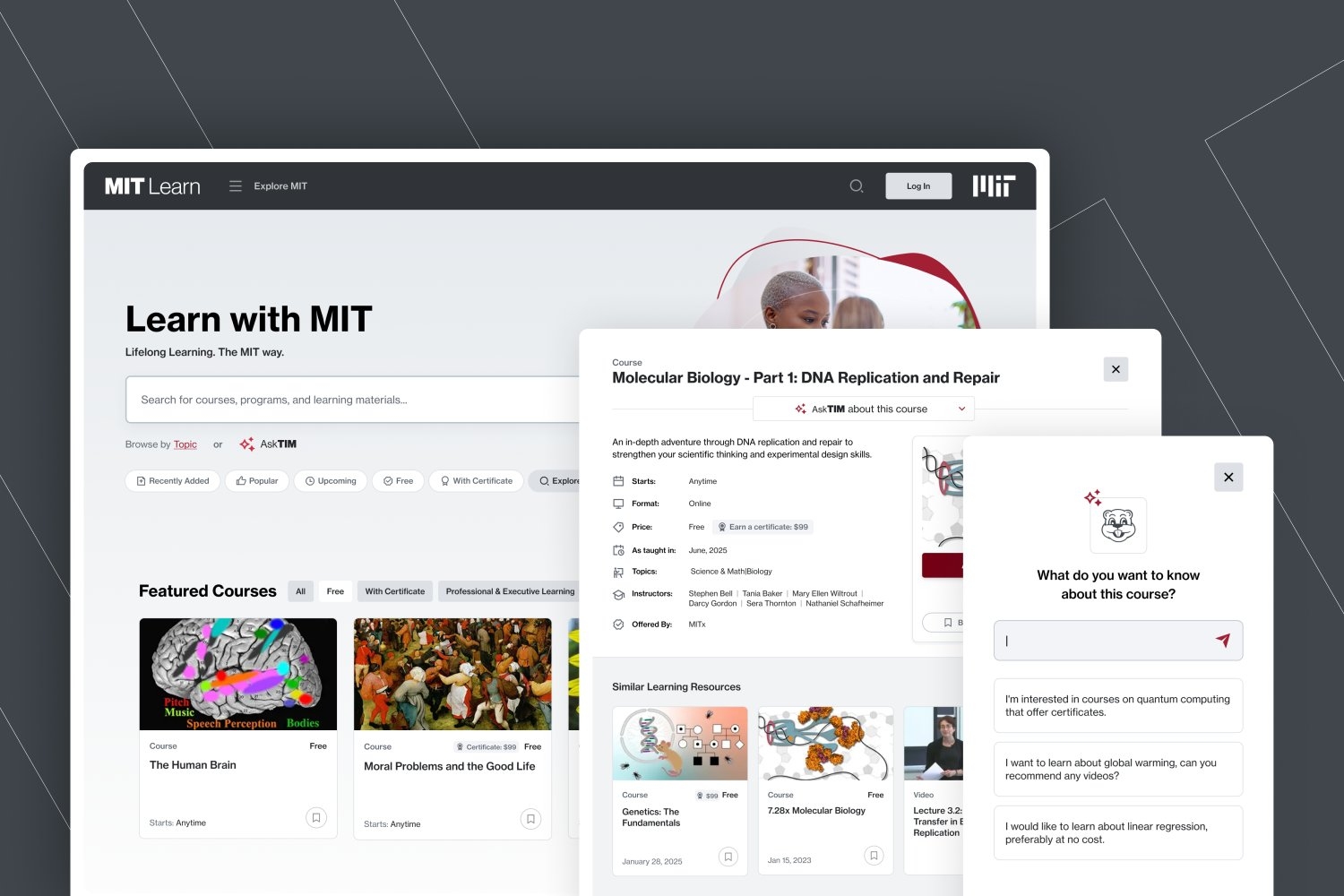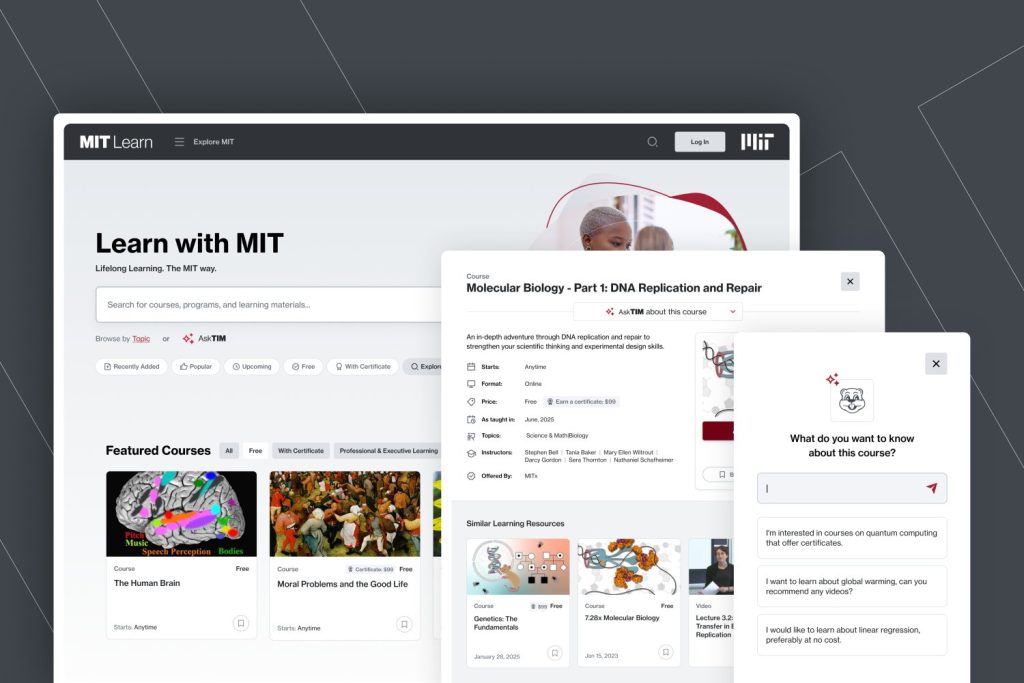
In 2001, MIT became the first higher education institution to provide educational resources for free to anyone in the world. Fast forward 24 years: The Institute has now launched a dynamic AI-enabled website for its non-degree learning opportunities, making it easier for learners around the world to discover the courses and resources available on MIT’s various learning platforms.
MIT Learn enables learners to access more than 12,700 educational resources — including introductory and advanced courses, courseware, videos, podcasts, and more — from departments across the Institute. MIT Learn is designed to seamlessly connect the existing Institute’s learning platforms in one place.
“With MIT Learn, we’re opening access to MIT’s digital learning opportunities for millions around the world,” says Dimitris Bertsimas, vice provost for open learning. “MIT Learn elevates learning with personalized recommendations powered by AI, guiding each learner toward deeper understanding. It is a stepping stone toward a broader vision of making these opportunities even more accessible to global learners through one unified learning platform.”
The goal for MIT Learn is twofold: to allow learners to find what they want to fulfill their curiosity, and to enable learners to develop a long-term relationship with MIT as a source of educational experiences.
“By fostering long-term connections between learners and MIT, we not only provide a pathway to continued learning, but also advance MIT’s mission to disseminate knowledge globally,” says Ferdi Alimadhi, chief technology officer for MIT Open Learning and the lead of the MIT Learn project. “With this initial launch of MIT Learn, we’re introducing AI-powered features that leverage emerging technologies to help learners discover the right content, engage with it more deeply, and stay supported as they shape their own educational journeys.”
With its sophisticated search, browse, and discovery capability, MIT Learn allows learners to explore topics without having to understand MIT’s organizational structure or know the names of departments and programs. An AI-powered recommendation feature called “Ask Tim” complements the site’s traditional search and browsing tools, helping learners quickly find courses and resources aligned with their personal and professional goals. Learners can also prompt “Ask Tim” for a summary of a course’s structure, topics, and expectations, leading to more-informed decisions before enrolling.
In select offerings, such as Molecular Biology: DNA Replication and Repair, Genetics: The Fundamentals, and Cell Biology: Transport and Signaling, learners can interact with an AI assistant by asking questions about a lecture, requesting flashcards of key concepts, and obtaining instant summaries. These select offerings also feature an AI tutor to support learners as they work through problem sets, guiding them toward the next step without giving away the answers. These features, Alimadhi says, are being introduced in a limited set of courses and modules to allow the MIT Open Learning team to gather insights and improve the learning experience before expanding more broadly.
“MIT Learn is a whole new front door to the Institute,” says Christopher Capozzola, senior associate dean for open learning, who worked with faculty across the Institute on the project. “Just as the Kendall Square renovations transformed the way that people interact with our physical campus, MIT Learn transforms how people engage with what we offer digitally.”
Learners who choose to create an account on MIT Learn receive personalized course recommendations and can create and curate lists of educational resources, follow their specific areas of interest, and receive notifications when new MIT content is available. They can also personalize their learning experience based on their specific interests and choose the format that is best suited to them.
“From anywhere and for anyone, MIT Learn makes lifelong learning more accessible and personalized, building on the Institute’s decades of global leadership in open learning,” says MIT Provost Anantha Chandrakasan.
MIT Learn was designed to account for a learner’s evolving needs throughout their learning journey. It highlights supplemental study materials for middle schoolers, high schoolers, and college students, upskilling opportunities for early-career professionals, reskilling programs for those considering a career shift, and resources for educators.
“MIT has an amazing collection of learning opportunities, covering a wide range of formats,” says Eric Grimson, chancellor for academic advancement, who oversaw the initial development of MIT Learn during his time as interim vice president for open learning. “The sheer size of that collection can be daunting, so creating a platform that brings all of those offerings together, in an easily searchable framework, greatly enhances our ability to serve learners.”
According to Peter Hirst, senior associate dean for executive education at MIT Sloan School of Management, one of the Institute’s incredible strengths is its sheer volume and diversity of expertise, research, and learning opportunities. But it can be challenging to discover and follow all those opportunities — even for people who are immersed in the on-campus experience. MIT Learn, he says, is a solution to this problem.
“MIT Learn gathers all the knowledge and learning resources offered across all of MIT into a learner-friendly, curatable repository that enables anyone and everyone, whatever their interests or learning needs, to explore and engage in the wide range of learning resources and public certificate programs that MIT has to offer and that can help them achieve their goals,” Hirst says.
MIT Learn was spearheaded by MIT Open Learning, which aims to transform teaching and learning on and off the Institute’s campus. MIT Learn was developed with the direction of former provost Cynthia Barnhart, and in cooperation with Sloan Executive Education and Professional Education. During the design phase, OpenCourseWare Faculty Advisory Committee Chair Michael Short and MITx Faculty Advisory Committee Chair Caspar Hare contributed key insights, along with other numerous faculty involved with Open Learning’s product offerings, including OpenCourseWare, MITx, and MicroMasters programs. MIT Learn is also informed by the insights of the Ad Hoc Committee on MITx and MITx Online.
“For over 20 years, MIT staff and faculty have been creating a wealth of online resources, from lecture videos to practice problems, and from single online courses to entire credential-earning programs,” says Sara Fisher Ellison, a member of the Ad Hoc Committee on MITx and MITx Online and the faculty lead for the online MITx MicroMasters Program in Data, Economics, and Design of Policy. “Making these resources findable, searchable, and broadly available is a natural extension of MIT’s core educational mission. MIT Learn is a big, important step in that direction. We are excited for the world to see what we have to offer.”
Looking ahead, MIT Learn will also feature selected content from the MIT Press. As MIT Learn continues to grow, Open Learning is exploring collaborations with departments across the Institute with the goal of offering the fullest possible range of educational materials from MIT to learners around the world.
“MIT Learn is the latest step in a long tradition of the Institute providing innovative ways for learners to access knowledge,” Barnhart says. “This AI-enabled platform delivers on the Institute’s commitment to help people launch into learning journeys that can unlock life-changing opportunities.”


